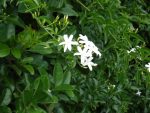
Brazilian jasmine is an evergreen, climbing, woody vine and a member of the olive family, Olaceae, that also includes lilac, privet, and forsythia. It is native to tropical west Africa but was introduced to America by Portuguese explorers by 1829 and introduced into Florida by 1920s as an ornamental and was considered a common weed by 1960. The plant grows on fences, power poles , hedges, roadsides, and riverbanks, as well as in pastures , agricultural fields, and forest openings. It has also invaded undisturbed hardwood forests in Florida where it climbs into the tree canopy and engulfs native vegetation. Both Puerto Rico and Hawaii have experiences similar problems with Brazilian jasmine. Plants like full sun but tolerate some shade, tolerate a variety of soils except wet, and can grow along the coast if protected from salt spray. They need at least 30” of rainfall a year and a minimum temperature of 35 F. USDA Hardiness Zones 10-11
Description: The young stems of this vine are densely hairy but mature ones are smooth and hairless. The opposite stalked leaves have 3 oval stalked leaflets with pointed tips and soft hairs on the upper surface; the terminal leaflet is larger than the other two. The white fragrant flowers are starshaped, carried in branched clusters at the leaf axils, and open at night all year around, most abundantly in spring. Fruits are small, fleshy, roundish , 2-lobed, and black. They are attractive to birds and raccoons that facilitate seed dispersal.
Control: Brazilian jasmine is difficult to control. Seedlings and small plants can be pulled up by hand but larg ones must be cut down to the ground and the stumps treated with an herbicide containing triclopyr. Since vines have a tendency to resprout, follow up treatments may be necessary.
To buy triclopyr from Amazon.com click here.
Photo Credit: Auckland Museum, Wikipedia